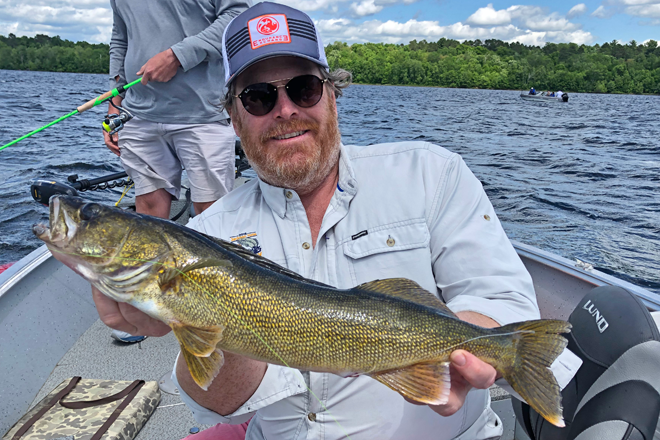A familiar fall scene on Cutfoot Sioux, crappies, and they are beginning to turn up in the mix of fish our guests are catching. These fish were caught on Saturday August 22nd by Keith Eden (L) and Kenny Shipler (R) using Little Joe Spinners tipped with fatheads.
Nomadic in nature, crappies travel between summer and fall haunts as the lake transitions from the warm water period, into the cool water season.
For a time, crappie locations vary with both the weather and time of day. During early morning and late evening, some of them are sneaking out of vegetation and showing up along steep breaklines in water depths of 18 to 24 feet. Inside turns, adjacent to weedy flats and close the shoreline are key early season locations.
It is cool weather that helps accelerate the movement out of shallow weeds, but when conditions warm and the sun shines, many crappies will retreat back into heavy cover. Cabbage, Coontail and Wild Celery are the 3 most common locations to find them. For the moment, Cabbage appears to be the most preferred cover; that’s where the fish you see here were caught.
Presentation depends on both angler preference and level of skill. Trolling spinners tipped with fatheads is often the easiest way for folks to catch crappies in the cabbage, but not necessarily the most efficient. For peak efficiency, skilled anglers casting small jigs tipped with plastic tails are likely to do better. Creep along the weedline, casting into pockets and gaps in the vegetation using a drop-swim-drop retrieve.
Walleyes and the development of Winnie’s 2018 year class have been on the minds of anglers for a while. Now, many of those 2018 fish are reaching maturity and some of them are also reaching the fish cleaning station.
“They’re not big, but they are plentiful and folks have been anxious to get after them; almost everyone is catching fish each day. If you were to voluntarily set your sights on a 14 inch minimum size, you will catch enough “keepers” for the dinner table and have plenty of action too.” So say’s Reed Ylitalo, one of our preferred fishing guides on both Winnie and Cutfoot.
“Most folks are trolling spinners and they might be catching larger numbers of fish than me. But I’ve been fishing with jigs, tipped with decent size minnows and on average; I think it has helped my customers’ a little bit larger size fish. I’m using a 1/8 ounce Lindy Live bait Jig tipped with shiners when I can get them. Larger fatheads or rainbows will also work in a pinch.” Ylitalo added.
Walleye locations are all over the map this year, aided in part by the lake’s heavier than average algae bloom. With diminished water clarity, walleyes will move into shallow water on breezy days or during prime time feeding periods early and late in the day. It has not been unusual to catch fish in 6 to 8 feet of water; folks who have been coming here for a long time are reminded of how walleye fishing was during the “good old days”, the pre-Zebra Mussel times.
Don’t expect fish to bite all day long in the shallows though, especially not on bright, calm days. During mid-day, it’s been easier to find and catch fish in deeper water. Some of the lakes larger bars are holding fish and fishing the breaklines in 18 to 26 feet can be productive during the day.
Some of the shoreline points that lead into deep water are productive too. Fish that move shallow to feed in the morning, move deeper during the daytime. A good example would be fish that inhabit the area near Stony Point. It’s been common to for fish to migrate back and forth between shallow and deeper water; sometimes several times a day.
The lakes flats have been productive at times too; gravel and rock patches will hold fish periodically. There was an article about fishing the flats last week that contained some good tips. If you’re interested, you might want to check it out using this link to Jeff Sundin Lake Winnie Report August 19, 2020
The changeable locations will keep anglers on their toes; but anyone who keeps searching is going to be rewarded with some decent action.
Adding to the action are both perch and pike, they have been available in good numbers. The average sizes have been respectable too; anglers could set their sights on perch over 10 inches and easily be able to gather plenty for a meal.
Pike in Winnie appear to be helped by the “Northern Zone” 22 to 26 protected slot limit. This season, it has been much easier to find and catch fish that have crossed over the 26 inch mark. We haven’t seen many fish over 30 inches yet, but there have been lots of 26 to 27 inch fish.
Most of our guests are catching pike while they pursue walleyes. Whether they’re trolling spinners or using jigs and minnows, the pike just come along occasionally. Trolling crankbaits on the flats, especially the large flats on both Center and Bena Bars will produce good numbers of pike too. And if you’re into live bait rigging, A Lindy Rig tipped with large creek chubs or sucker minnows will produce fish too. The steep breaklines on all of the lakes larger mid-lake bars are good locations for rigging pike.
With fall just around the corner, it appears that our guests are in for a treat. Proven populations of walleye, pike and perch should keep most folks busy. The jury is still out about how good the panfish action will be, but there are early indications that there will be good news on that front too. All in all, it looks like we have a great fall headed our way!











